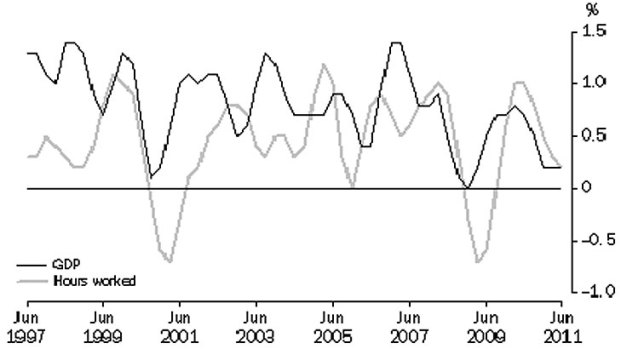By Michael Pascoe
Amidst the mostly good news in yesterday's national accounts figures, there was one potentially worrying chart - the history of quarterly GDP movements plotted against the trend figure for hours worked.
Given today's uptick in unemployment, it was a very timely reminder of the labor force implications of even a mildly slower rate of economic growth.

Quarterly GDP hours worked trend. Source: ABS
Superficially, the chart above confirms what everybody knows about employment being a lagging indicator, but a closer look shows it's a little more complicated than that. Employment (or at least hours worked) lags more on the upside than it does on the down.
In the two major downturns this century, growth in hours worked dived pretty much in unison with GDP growth slowing and then overshot GDP into negative territory, taking several months to get back into the positive.
The slowing in the rate of GDP growth over 2010-11 isn't the same as the dot bomb and GFC episodes – it didn't slow as quickly and has bottomed out earlier.
Furthermore, the details of the national accounts for the June half year show the straight GDP measure tells a good deal less than the full story thanks to flooded coal mines.
So it shouldn't surprise that the trend hours worked line isn't quite in unison with the GDP, but it's not far removed.
Speed bump
And that makes what happens next more interesting. Forecasts from the Reserve Bank, Treasury and the vast majority of the economics trade have our economy picking up speed this financial year, North Atlantic wobbles notwithstanding.
Today's employment statistics, though, pose the question of whether hours worked will overshoot the GDP recovery again and by how much.
At present it's more a political problem than an economic one – so long as you're not the marginal one unable to find a job.
The trend unemployment rate has remained steady for the past year at “around 5 per cent”, as the RBA likes to put it. Whether it's 4.9, 5 or 5.1 per cent, it's much of a muchness to the Reserve Bank – and the flighty seasonally adjusted measure that makes for better headlines matters less.
Trend hours worked have been consistently growing by two or three million every month for the past year.
But if the decline in the hours worked overshoots the GDP graph, that unemployment headline rate will become uncomfortable for a government that has wedged itself with a budget surplus next year even though fiscal policy is keeping growth subdued.
And the Liberal Party will be as understanding about any surplus slippage as it is on the Malaysian solution.
Stimulus targets
That predicament is most unfortunate as there are opportunities for intelligent, targeted stimulus if Australia wanted to keep the unemployment rate closer to 5 than 5.5 per cent.
The national accounts show construction outside the resources industry is doing little and our investment in new housing remains flat, as it has been, more or less, for the past seven years.
At the same time (and partially because of that lack of investment) housing affordability remains a crisis for many of the poorest members of our community.
A burst of building government-owned social housing with a medium-term goal of selling it to the tenants would be an investment rather than a splurge, have the nice retail multiplier effect that new housing entails and fill part of the gap for the construction industry that the winding down of the school sheds program has left.
And, unlike Mickey Mouse first-home owner grants, building social housing doesn't mean the money goes straight to the vendors.
But with a Federal Government wedged on deficit politics and State Governments all at various levels of being tightly budgeted, that's not going to happen, even if you could find a bureaucracy capable of efficiently supervising such a stimulus.
RBA ammo
Thus we're left to contemplate the employment statistics, wondering about the chance of overshooting, and trust the employment lag won't be too long on the upside and growth strengthens on the back of the solid commodities and capex booms.
As to the wild card – the chance that the North Atlantic does something more stupid than it already has – we would be mainly reliant on monetary policy to cushion us.
Just as well the RBA has plenty of ammunition that it's keeping dry. Politics has neutered fiscal policy just when it should still have been celebrating its GFC success.
Michael Pascoe is a BusinessDay contributing editor.